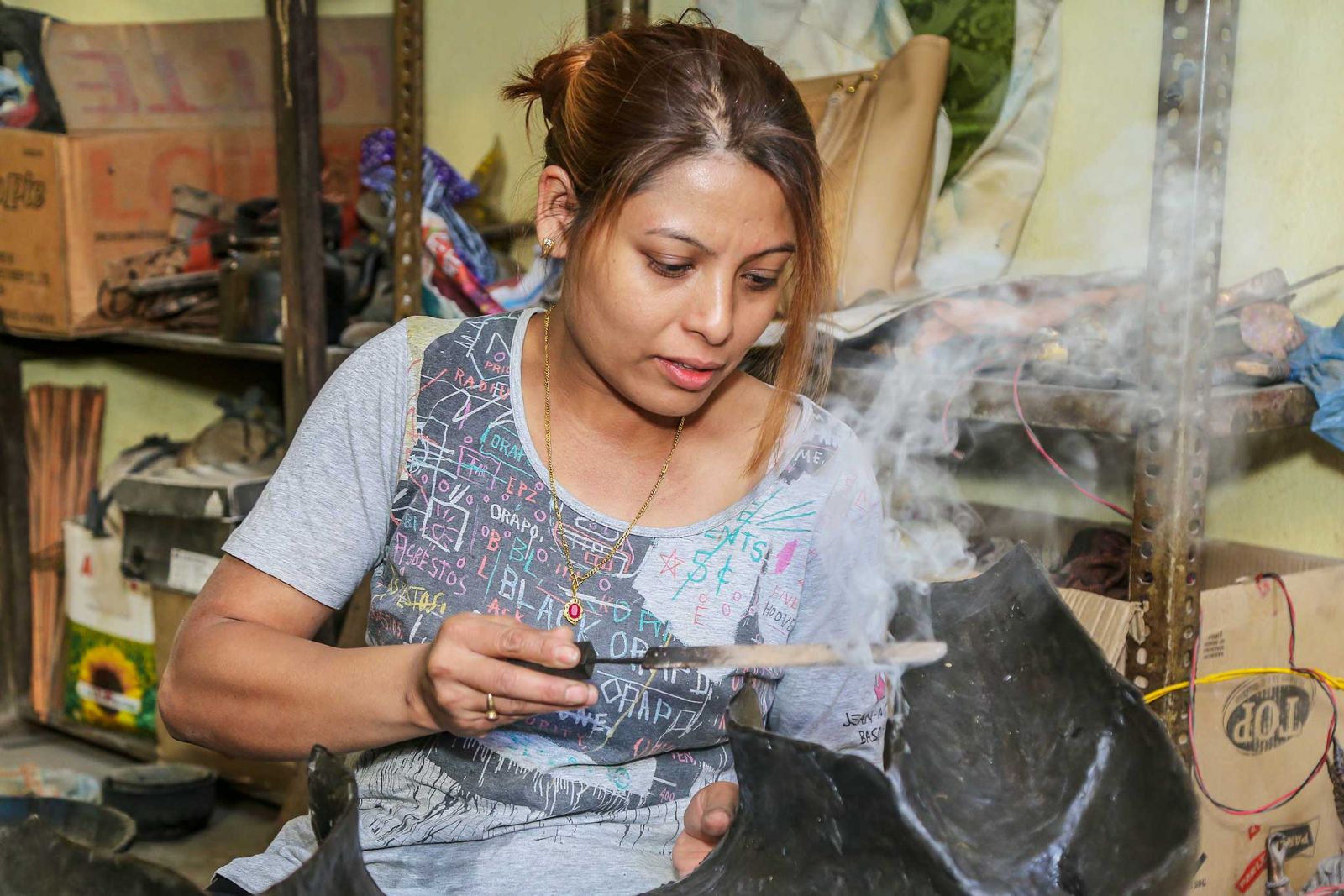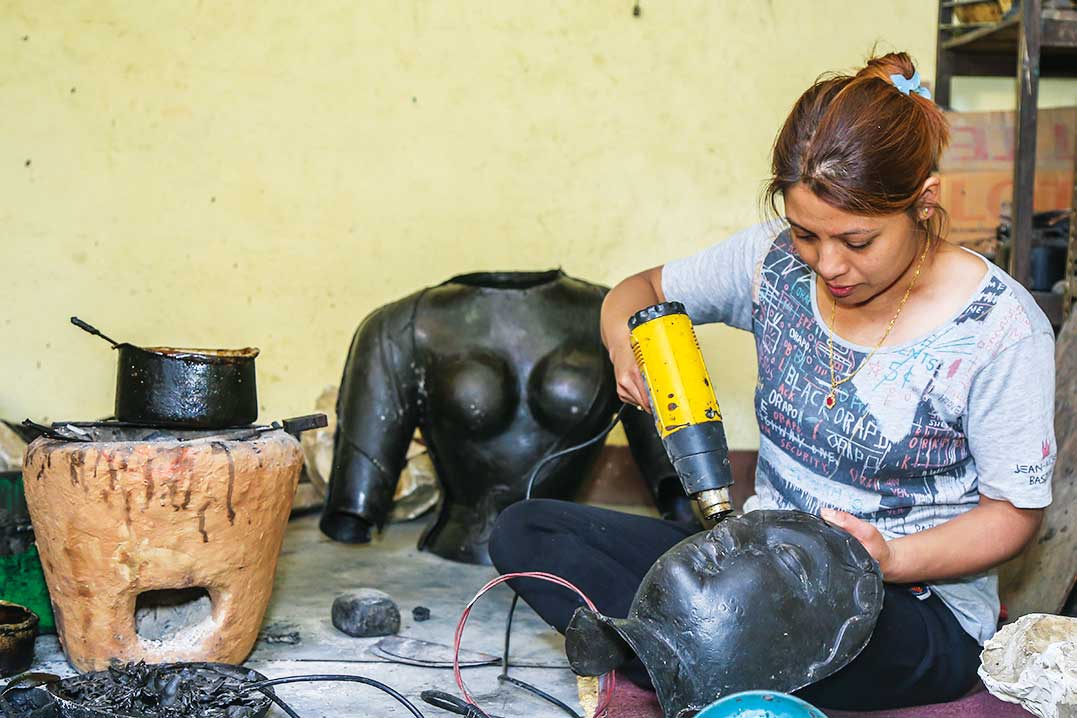As it is, due to the rampant migration of the young to foreign lands for employment (some lucrative, some so-so) there is already a shortage of workers in many sectors of the economy, including handicrafts. Add to this the fact that handicrafts need talented hands, and what with the breakdown of the tradition of such skills being handed down from one generation to another (with more young people opting for less demanding jobs), what you get is a sector that could be facing a crisis in the near future.
 In light of this, it was so very refreshing (and inspiring, too) to spend an hour or so with Sabina Shakya (Mahat) at her place of work in Patan, watching her adept hands coax life out of pliable, but lifeless, wax. Her place of work being the workshop on the ground floor of her father’s house in the courtyard behind the famous RudravarnaMahavihar in Okubahal of the ‘city of the arts’. Her father, meaning one of the most renowned metal sculptors in the country, Mr. Shanta Kumar Shakya, who specializes in making statues of a particularly exotic deity, Sahasra-bhujaAvalokiteÅ›vara (Thousand Armed Avalokiteshvara), who has 48 principal arms holding various instruments, with the numerous other arms forming the background.
In light of this, it was so very refreshing (and inspiring, too) to spend an hour or so with Sabina Shakya (Mahat) at her place of work in Patan, watching her adept hands coax life out of pliable, but lifeless, wax. Her place of work being the workshop on the ground floor of her father’s house in the courtyard behind the famous RudravarnaMahavihar in Okubahal of the ‘city of the arts’. Her father, meaning one of the most renowned metal sculptors in the country, Mr. Shanta Kumar Shakya, who specializes in making statues of a particularly exotic deity, Sahasra-bhujaAvalokiteÅ›vara (Thousand Armed Avalokiteshvara), who has 48 principal arms holding various instruments, with the numerous other arms forming the background.
At the moment, however, Sabina was hard at work in creating a wax mold of the Green Tara (the workshop also makes statues of many other deities), a five-foot image, when finished, that is destined for Tibet. As is well known, in Nepal, the ‘lost wax method’ is generally used to make metal statues, and it consists of various steps. “Such a statue usually takes about eight months to be finished,” says Sabina. “Much depends on factors like the weather (the casts have to be air-dried till they harden) and the availability of crafts people.”
 She herself has two assistants, and admits, “Even if one is absent, my work will be delayed.” Which obviously delay the other steps, such as the cast and mold making, as well as the finishing. The making of the wax mold, as well as the other steps, require concentration and dedication, along with a lot of patience. “If someone thinks of doing this work as just a past-time, that’s not possible,” she asserts. “One has to be really committed.”
She herself has two assistants, and admits, “Even if one is absent, my work will be delayed.” Which obviously delay the other steps, such as the cast and mold making, as well as the finishing. The making of the wax mold, as well as the other steps, require concentration and dedication, along with a lot of patience. “If someone thinks of doing this work as just a past-time, that’s not possible,” she asserts. “One has to be really committed.”
Besides her father, some other members of the family are also involved in the business, with her brother not only looking after business, but also lending his capable hands in the workshop. Her younger sister does face painting of the statues (a delicate task) while her sister-in-law does the ornamentation work. “My father makes the masterpieces, from which the statues come to life. My brother is also good at this, but I am less so,” she admits with refreshing honesty.
She reveals that, although she grew up in this artistic environment, learning what she could by being of help here and there, it was only after she finished her SLC that she began to be more involved. “I would say that I took up this work seriously some twenty years ago.” That’s quite a lot of experience, and one can see it shining through her entire demeanor as she confidently gives a strong tap here and presses a spot there, deeply engrossed in her work with the torso of the Green Tara in the making. Here, she makes another candid statement, off the cuff, as it were: “By now I should be passing on what I have learnt to others.” To the question of how long she will be continuing in this profession, she replies with a laugh, “As long as I am physically able to!”
.jpg) She certainly seems to be more than happy with what she is doing, and this is evident from her full-throated laughter from time to time at something humorous just said. This, I guess, is to be expected of someone who loves her chosen vocation, but of course, hers is not just any ordinary vocation. It is much more than that, with the results being awe-inspiring creations that dazzle and delight.
She certainly seems to be more than happy with what she is doing, and this is evident from her full-throated laughter from time to time at something humorous just said. This, I guess, is to be expected of someone who loves her chosen vocation, but of course, hers is not just any ordinary vocation. It is much more than that, with the results being awe-inspiring creations that dazzle and delight.











